
The Martin Mars air tanker will be joining the 747 air tanker in Mexico to help suppress the wildfires that are burning 30 to 40 miles south of the Texas border. According to an article in the Vancouver Sun, the government of Mexico has signed a 20-day contract with Coulson Flying Tankers. The aircraft was scheduled to depart from their Port Alberni, Canada base on Friday to begin the contract on Sunday, April 24.
The huge air tanker will be based at Lake Amistad reservoir near Del Rio, Texas. The lake straddles the U.S./Mexico border, and the aircraft will be moored on the U.S. side. It will scoop up to 7,200 gallons of water from the lake and then fly across the border 30 to 40 miles to the fires, returning to the lake each time it needs to refill. A conventional large air tanker can hold 2,000 to 3,000 gallons, while the DC-10 can carry 11,600 and the 747 has a 20,000-gallon tank.
There were only seven of these “flying boats” built, between 1945 and 1948. The U.S. Navy retired them in 1956 and then sold them to private companies. Four of them were converted to air tankers, or “water bombers” as they are called in Canada. One crashed on a fire in British Columbia 1961, killing the the four crewmembers, and another was destroyed by Typhoon Freda while the aircraft was parked onshore in 1962. The other two, the Hawaii Mars and Philippine Mars, entered the firefighting service in 1963 and are still flying today for Coulson Flying Tankers.
The Martin Mars has a modern firefighting system. In addition to the 7,200-gallon water capacity, it also carries 600 US gallons of foam concentrate which can be mixed with the water to enhance the fire suppression properties of the water. This is enough for 21 drops of a 0.4% solution. It also carries Thermo-Gel which can be mixed into the water, creating a gel which coats vegetation and structures providing more cooling and protection than plain water.
The U.S. Forest Service contracted with the Martin Mars for two to three months in 2009, basing it at Lake Elsinore in southern California. It worked on the Station fire and many others that year, but was not under contract in the U.S. in 2010.

The operation of the Martin Mars is somewhat unusual for air tankers, in that the ship comes with a helicopter, a Sikorsky S-76B. The helicopter has several roles, primarily serving as a lead plane and checking to make sure the water-scooping locations are free of boaters and other obstacles. Called Firewatch 76, it has infrared imaging capabilities and can also stream live video to the internet using 3G cell phone networks.

Below is a map of the fires in Texas. It also shows the fires across the border in Mexico that the Martin Mars and the 747 supertanker are or will be working on.
Continue reading “Martin Mars air tanker joins the fire fight in Mexico”









